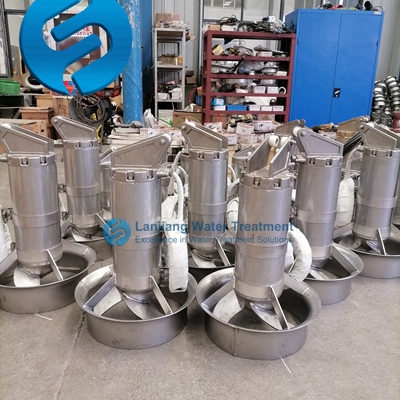The structure of the sewage mixer mainly includes the following parts:

First, shell and frame
Shell: usually made of cast iron or steel plate welded, with high strength and corrosion resistance. The main purpose of the housing is to protect the internal drive and impeller, and to connect the sewage mixer to the conveying line.
Rack: The rack part of the sewage mixer is the support structure of the entire equipment, which is usually welded with excellent carbon steel plate and channel steel, and passes strict product qualification standards and specific process requirements to ensure the stability and durability of the equipment.
Second, motor and transmission device
Motor: The motor is the power source of the sewage mixer, and the motor with good performance such as waterproof and dustproof is usually selected to ensure stable operation in the harsh sewage treatment environment. The power of the motor depends on the size and application range of the sewage mixer, usually between a few kilowatts and tens of kilowatts.
Transmission device: The transmission device connects the motor and the impeller to transfer the power of the motor to the impeller. The transmission device is usually composed of a reducer, a coupling, a bearing, etc. The vertical sewage treatment mixer often uses cycloidal pinwheel reducer to drive the spindle to rotate, and the working part of the main machine uses nylon pins as transmission connectors to achieve power transmission and drive.
Third, impeller and mixing paddle
Impeller: The impeller is the core part of the sewage mixer, which mixes the sewage evenly by rotating motion. The shape and size of the impeller directly affect the mixing effect, which is usually divided into different forms such as one-word blade, three-word blade and six-word blade. According to the different working environment, the selection of different types of impeller can improve the stirring effect of sludge.
Mixing paddle (in some mixers) : The mixing paddle is also a key component, and its shape and size also affect the mixing effect. Mixing paddles are usually made of corrosion-resistant materials such as stainless steel or plastic to adapt to the harsh environment of sewage treatment.
Fourth, other auxiliary components
Sealing mechanism: For submersible sewage mixer, the sealing mechanism is a key component to ensure that the motor and transmission will not leak when working under the liquid. Two independent mechanical seals are usually used, and the friction secondary material is corrosion-resistant and wear-resistant alloy and silicon carbide to ensure the reliability and durability of the seal.
Guide cover: The guide cover is used to guide the water flow to make the water flow more evenly through the impeller and improve the mixing effect. At the same time, the guide hood can also reduce the impact of water on the impeller and wear, extend the service life of the equipment.
Electrical control part: including wires, plugs, controllers, etc., used to control the motor start, stop and speed adjustment and other functions. The electrical control section shall be safe and reliable and comply with the relevant electrical safety standards.
To sum up, the structure of the sewage mixer is complex and fine, and all parts cooperate with each other to achieve uniform mixing and mixing of sewage. When purchasing and using a sewage mixer, it should fully understand its structural composition and working principle to ensure the stability and durability of the equipment, and meet the needs of sewage treatment.
Nanjing LanJiang Water Treatment Equipment Co.,Ltd manufactures equipment for wastewater treatment. We were established in 2001. Since then, we designed and produced submersible mixers, top entry mixers, aerators and other wastewater treatment equipment.
Post time:2024-10-14